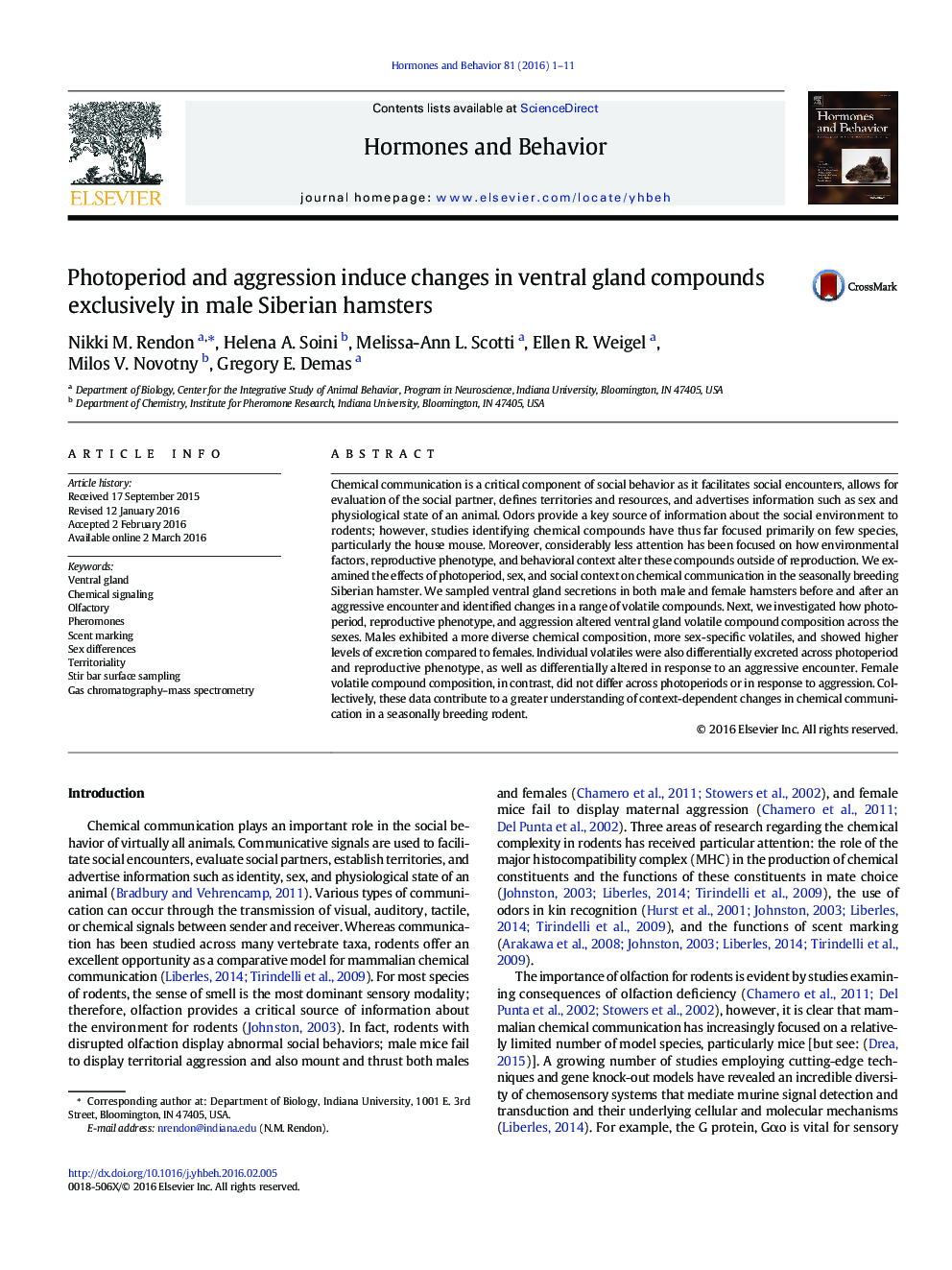| کد مقاله | کد نشریه | سال انتشار | مقاله انگلیسی | نسخه تمام متن |
|---|---|---|---|---|
| 6794380 | 540625 | 2016 | 11 صفحه PDF | دانلود رایگان |
عنوان انگلیسی مقاله ISI
Photoperiod and aggression induce changes in ventral gland compounds exclusively in male Siberian hamsters
ترجمه فارسی عنوان
عکسبرداری و تجاوز باعث ایجاد تغییرات در ترکیبات غدد درشت می شود که به طور انحصاری در همسترهای مرد سیبری قرار دارد
دانلود مقاله + سفارش ترجمه
دانلود مقاله ISI انگلیسی
رایگان برای ایرانیان
کلمات کلیدی
غدد درون ریوی، سیگنالینگ شیمیایی، رفلاکس، فرومون ها، علامت گذاری بو، تفاوت های جنسی، قلمروی، نمونه برداری سطح بطری را مخلوط کنید طیف سنجی جرم کروماتوگرافی گاز،
ترجمه چکیده
ارتباطات شیمیایی جزء حیاتی رفتار اجتماعی است، زیرا آن را تسهیل برخورد اجتماعی، اجازه می دهد تا برای ارزیابی شریک اجتماعی، تعریف سرزمین ها و منابع، و تبلیغ اطلاعات مانند جنسیت و وضعیت فیزیولوژیکی یک حیوان. بوی ها یک منبع کلیدی از اطلاعات مربوط به محیط اجتماعی برای جوندگان است؛ با این حال، مطالعاتی که ترکیبات شیمیایی را شناسایی کرده اند، تا کنون عمدتا بر روی چند گونه، به خصوص موش خانه، متمرکز شده است. علاوه بر این، توجه به مراتب کمتر به این موضوع پرداخته شده است که چگونه عوامل محیطی، فنوتیپ های تولید مثل و شرایط رفتاری این ترکیبات را خارج از بازتولید تغییر می دهند. ما اثرات فتوتریدها، جنس، و بستر اجتماعی را بر ارتباطات شیمیایی در هامستر سیبری فصلی بررسی کردیم. ما ترشحات غدد درشتی را در هر دو همستر نر و ماده قبل و بعد از روبرو شدن با تهاجمی انتخاب کردیم و تغییرات در تعدادی از ترکیبات فرار را شناسایی کردیم. سپس، ما بررسی کردیم که چگونه فتوتروئید، فنوتیپ تکثیر و پرخاشگری ترکیب ترکیبات ناپایدار غدد درشت را در سراسر جنس تغییر می دهد. مرد ها ترکیب شیمیایی متنوعتری داشتند، فرآورده های خاصی از جنس را نشان دادند و سطوح بالاتر دفع آنها را نسبت به زنان نشان دادند. انفجار فردی نیز در طول فتوترو و فنوتیپ تولید مثل منحرف شد و همچنین در پاسخ به یک برخورد تهاجمی متفاوت بود. در مقابل، ترکیب ترکیبات فرار زن در دوره فوتون یا در پاسخ به تجاوز تفاوت نداشت. به طور خلاصه، این داده ها به درک بیشتر از تغییرات وابسته به زمینه در ارتباطات شیمیایی در جوندگان پرورش فصلی کمک می کند.
موضوعات مرتبط
علوم زیستی و بیوفناوری
بیوشیمی، ژنتیک و زیست شناسی مولکولی
علوم غدد
چکیده انگلیسی
Chemical communication is a critical component of social behavior as it facilitates social encounters, allows for evaluation of the social partner, defines territories and resources, and advertises information such as sex and physiological state of an animal. Odors provide a key source of information about the social environment to rodents; however, studies identifying chemical compounds have thus far focused primarily on few species, particularly the house mouse. Moreover, considerably less attention has been focused on how environmental factors, reproductive phenotype, and behavioral context alter these compounds outside of reproduction. We examined the effects of photoperiod, sex, and social context on chemical communication in the seasonally breeding Siberian hamster. We sampled ventral gland secretions in both male and female hamsters before and after an aggressive encounter and identified changes in a range of volatile compounds. Next, we investigated how photoperiod, reproductive phenotype, and aggression altered ventral gland volatile compound composition across the sexes. Males exhibited a more diverse chemical composition, more sex-specific volatiles, and showed higher levels of excretion compared to females. Individual volatiles were also differentially excreted across photoperiod and reproductive phenotype, as well as differentially altered in response to an aggressive encounter. Female volatile compound composition, in contrast, did not differ across photoperiods or in response to aggression. Collectively, these data contribute to a greater understanding of context-dependent changes in chemical communication in a seasonally breeding rodent.
ناشر
Database: Elsevier - ScienceDirect (ساینس دایرکت)
Journal: Hormones and Behavior - Volume 81, May 2016, Pages 1-11
Journal: Hormones and Behavior - Volume 81, May 2016, Pages 1-11
نویسندگان
Nikki M. Rendon, Helena A. Soini, Melissa-Ann L. Scotti, Ellen R. Weigel, Milos V. Novotny, Gregory E. Demas,
